







It's a … well, we don't know the sex yet. A female prehensile-tailed porcupine gave birth to this baby at the Smithsonian Institution's National Zoo in Washington, D.C., earlier this month. (The zoo released the photo Tuesday.) Staff say they wouldn't normally know if the newborn is a boy or a girl for another six months, but this time they'll use DNA tests to solve the mystery sooner.
Native to South America, prehensile-tailed porcupines (Coendou prehensilis) are mostly nocturnal. The plant-eaters use their nimble tails to climb and hang from trees and are known to stamp their hind feet when excited. As for their big noses, the rodents' keen sense of smell helps compensate for their nearsightness.
In case you're wondering, the recent birth at the zoo wasn't as painful as the animal's porcupine name might imply. C. prehensilis infants are born with fur, not quills.





 Rated M for mature.
Rated M for mature.





The US military is funding development of a weapon that delivers a bout of excruciating pain from up to 2 kilometres away. Intended for use against rioters, it is meant to leave victims unharmed. But pain researchers are furious that work aimed at controlling pain has been used to develop a weapon. And they fear that the technology will be used for torture.
***********
New Scientist contacted two researchers working on the project. Martin Richardson, a laser expert at the University of Central Florida, US, refused to comment. Brian Cooper, an expert in dental pain at the University of Florida, distanced himself from the work, saying "I don't have anything interesting to convey. I was just providing some background for the group." His name appears on a public list of the university's research projects next to the $500,000-plus grant.
John Wood of University College London, UK, an expert in how the brain perceives pain, says the researchers involved in the project should face censure. "It could be used for torture," he says, "the [researchers] must be aware of this."
Amanda Williams, a clinical psychologist at University College London, fears that victims risk long-term harm. "Persistent pain can result from a range of supposedly non-destructive stimuli which nevertheless change the functioning of the nervous system," she says. She is concerned that studies of cultured cells will fall short of demonstrating a safe level for a plasma burst. "They cannot tell us about the pain and psychological consequences of such a painful experience."
The US network of satellites monitoring the environmental health of the Earth is on the verge of collapse, according to a highly critical report released on Wednesday by the country’s National Research Council.
Six recent NASA Earth-observing missions have been delayed, scaled back or completely cut. Several of the cancelled missions were follow-ups to successful satellite projects.
The US is probably responsible for about half of the Earth-science satellites currently in orbit, says Richard Anthes, president of the University Corporation for Atmospheric Research and co-chair of the committee that produced the report.
Most of the document focuses on research satellites, and Anthes warns that, for example, these map bulges in the Earth that may signal impending volcanic eruptions, track the depleted ozone layer, and analyse changes in soil moisture that may precede a famine. Furthermore, if observational satellites are not replaced weather and hurricane forecasting would suffer.
When current satellites retire, scientists fear there may be a serious data gap. “The planning for new missions should probably have been started five to 10 years ago,” says Anthes. “But the community is now waking up.”
President George W Bush’s proposed budget for Fiscal Year 2006 lists Earth studies as one of NASA’s five national objectives. But in that budget, NASA’s Earth science programmes would get $1.37 billion, about 8% less than they received the year before.
Do you want a seven-day weather forecast for your ZIP code? Or hour-by-hour predictions of the temperature, wind speed, humidity and chance of rain? Or weather data beamed to your cellphone?
That information is available for free from the National Weather Service.
But under a bill pending in the U.S. Senate, it might all disappear.
The bill, introduced last week by Sen. Rick Santorum, R-Pa., would prohibit federal meteorologists from competing with companies such as AccuWeather and The Weather Channel, which offer their own forecasts through paid services and free ad-supported Web sites.
"I believe I've paid for that data once. ... I don't want to have to pay for it again," said Scott Bradner, a technical consultant at Harvard University.
He says that as he reads the bill, a vast amount of federal weather data would be forced offline.
"The National Weather Service Web site would have to go away," Bradner said. "What would be permitted under this bill is not clear — it doesn't say. Even including hurricanes."
"It is not an easy prospect for a business to attract advertisers, subscribers or investors when the government is providing similar products and services for free," Santorum said.
AccuWeather has been an especially vocal critic of the weather service and its parent agency, the National Oceanic and Atmospheric Administration.
The company has accused the federal agencies of withholding data on hurricanes and other hazards, and failing to ensure that employees don't feed upcoming forecasts to favored investors in farming and energy markets.

 Is this caused by intelligent or stochastic mechanisms?
Is this caused by intelligent or stochastic mechanisms?
Some complex organic molecules - such as benzene and diacetylene - had already been picked up on an earlier approach to Titan, but the latest encounter has yielded an even wider range.
It includes nitriles and scores of different hydrocarbons, some with up to seven carbon atoms. And the results suggest that Titan's upper atmosphere holds even heavier and more complex organics, which are beyond the instrument's mass range.
Scientists do have some idea about how they are formed, however. Methane and molecular nitrogen are thought to be smashed apart by ultraviolet radiation from the Sun and by high energy particles trapped in Saturn's magnetic field. That creates highly reactive radicals that can combine to form more complex molecules.
Similar processes might have operated on the Earth a few hundred million years after it formed, generating the raw materials for life. On the other hand, Earth's organics may have been created in deep space and then delivered by comets.
“Intelligent design.” To hear some folks talk, you’d think it’s a scam to sneak Genesis into science classrooms. Yet intelligent design has nothing to do with the six days of creation and everything to do with hard evidence and logic.
For example, consider the cell. Even the simplest cells bristle with
high-tech machinery. On the outside, their surfaces are studded with sensors, gates, pumps and identification markers. Some bacteria even sport rotary outboard motors that they use to navigate their environment.
Inside, cells are jam-packed with power plants, assembly lines, recycling units and more. Miniature monorails whisk materials from one part of the cell to another.




ID theorists contend that living organisms like the cell appear designed because they are designed. And they’ve developed rigorous new concepts to test their idea.
In contrast to what is called creation science, which parallels biblical theology, ID rests on two basic assumptions: namely, that intelligent agents exist and that their effects are empirically detectable.
Its chief tool is specified complexity. That’s a mouthful, and the math behind it is forbidding, but the basic idea is simple: An object displays specified complexity when it has lots of parts arranged in a recognizable pattern.

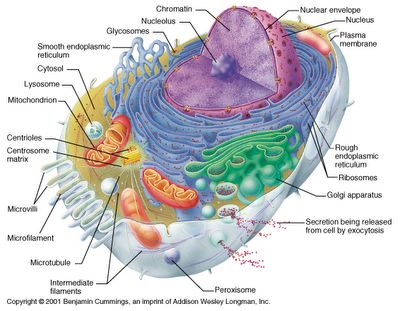
The effectiveness of such thinking is confirmed by massive experience . As William Dembski, author of “The Design Inference,” points out, “In every instance where we find specified complexity, and where (its) history is known, it turns out that design actually is present.”
To see how this applies to biology, consider the little outboard motor that bacteria such as E. coli use to navigate their environment. This water-cooled contraption, called a flagellum, comes equipped with a reversible engine, drive shaft, U-joint and a long whip-like propeller. It hums along at a cool 17,000 rpm. And flagellum is integrated into a sensory/guidance system that maneuvers the bacterium toward nutrients and away from noxious chemicals — a system so complex that computer simulation is required to understand it in its entirety. That system is meshed with other systems.

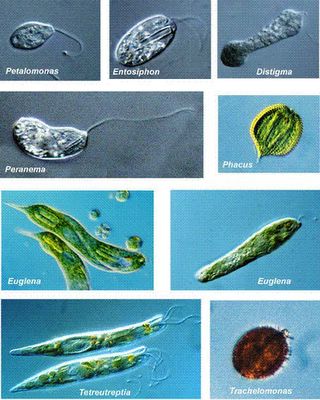
In fact, if you want to run the numbers, as Dembski does in his book “No Free Lunch,” it boils down to the following: If every elementary particle in the observed universe were cranking out mutation events at the cosmic speed limit for a billion times the estimated age of the universe, they still could not produce the genes for a working flagellum.
Of course, what’s important here is not what we conclude about the flagellum or the cell, but how we study it. Calling design theorists religious is just a cheap way to dodge the issues.
Putting more evangelicals on the court will mean rulings more in tune with the
religious convictions of churchgoers, said R. Albert Mohler Jr., president of
the Southern Baptist Theological Seminary in Louisville.
"We are not asking
for persons merely to be moral," Mohler said. "We want them to be believers in
the Lord Jesus Christ."
ID proponents have not only failed to provide any evidence for their thesis, they aren't even trying. There are no labs doing research on this subject; all the papers the Discovery Institute has tried to publish are exercises in spin, in which they try to distort biology researchers' work to fit their preconceptions.
******With no established body of results, no current work and no promising prospects for future research, why should ID be supported? It's a dead end. It is absurd to propose that our kids learn about a subject that no legitimate scientists are pursuing and that has no utility.******
My own discipline of developmental biology has been revolutionized in the last few decades as we've embraced evolution more fully than before; new papers in the rapidly growing field of evo-devo, or evolutionary developmental biology, pile up on my desk faster than I can read them.
This is a genuinely exciting time to be studying biology. When students ask me about the hot fields that promise great careers, I steer them toward evo-devo (and developmental biology in general), bioinformatics, proteomics and genomics, all fields in which knowledge of evolution is indispensable.
Note that I do not and cannot recommend anything to do with ID, whose proponents spend their time lobbying school boards, producing nothing new, and with no promise of new ideas for the future.
(all emphasis are mine- afarenis)
Here’s the question, from a bright young woman who identified herself as a chemistry major. “What you’ve said so far,” she remarked, “sounds like magic to me. I’ve tried magic chemistry, and it just doesn’t work. Aside from poking holes in evolution, what evidence can you show me for intelligent design?
******
Evidence is a funny thing, I said to her. There was a titter of laughter from the audience –- and now the reader must picture what follows as being spoken in sentence fragments at roughly 375 miles per hour."
Note that the data themselves in my thought experiment are exactly the same for the design skeptic and the design proponent. What renders the narrow band and primes evidence of intelligence is a causal impotence claim –- no natural mechanism exists to cause x –- coupled with a causal sufficiency claim –- intelligence, uniquely in our experience, produces narrow band radio transmissions and prime numbers. Because of its logical form, however (a universal negation), the causal impotence claim cannot be proven. No failed search for a natural mechanism, a necessarily finite search in any instance, can turn back one’s prior conviction that a mechanism nevertheless exists, lying perhaps just beyond the horizon of our current investigations. Until we find that natural mechanism, say the design skeptics, “we can content ourselves with regularities, chance, and ‘don’t know’ explanations” (Wilkins & Elsberry, Biology & Philosophy 16 [2001]:721).
Impasse. As Bill Dembski puts it, “the universe of unknown material mechanisms can never be exhausted” (The Design Revolution, p. 222). To exhaust that universe would be to solve the problem of induction. It is a logical impossibility.
Thus to elevate data to the status of “evidence” requires a decision that is not, strictly speaking, supported by the data themselves. This is an instance of the classical problem of the underdetermination of theory by data, and one of the reasons that the design debate is so heated.
With no established body of results, no current work and no promising prospects for future research, why should ID be supported? It's a dead end.
Since religious conservatives in the United States have been unsuccessful in preventing evolution from being taught in public- school science classes, they have had to resort to other tactics to inject their religious ideology into secular education. One such tactic has been the attempt to place stickers, which provide a cautionary disclaimer about the theory of evolution, on biology textbooks. This practice first began in Alabama in 1996, where stickers on biology textbooks proclaimed that evolution is a "controversial theory which some scientists present as a scientific explanation for the origin of living things."
Other states have since followed suit. In Cobb County, Georgia, the site of the most recent legal dispute over the matter, the stickers reads, "This textbook contains material on evolution. Evolution is a theory, not a fact, regarding the origin of living things. This material should be approached with an open mind, studied carefully, and critically considered." Proponents of the stickers argue that science textbooks present the theory of evolution as fact and that such warnings are necessary to counterbalance the effect of such a presentation. The goal, they argue, is not to restrict the teaching of evolution but rather to foster critical thinking among students, to promote tolerance and diversity, and to ensure a posture of neutrality toward religion.
In reality, however, we all know what reaction this compromise would prompt among religious conservatives. They would be livid, most likely claiming that the sticker violates their constitutional right to religious freedom. And therein lies the hypocrisy that ultimately bankrupts their position. In reality, religious conservatives are only interested in encouraging skepticism and critical thinking when it comes to questioning evolution. They have little real desire to encourage critical thinking generally and even less if that critical thinking is directed toward their religion.



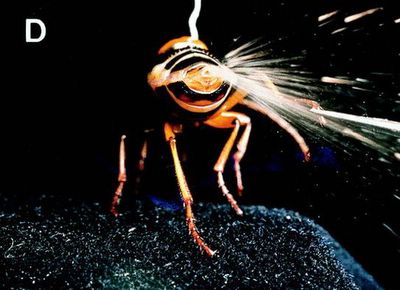



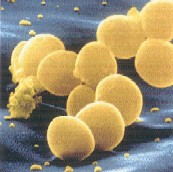


Staphylococcus aureus, a common germ that infects countless scrapes and scratches a year, is fast becoming an uncommon public health threat. Drug-resistant strains of staph known as MRSA, once confined to hospitals and nursing homes, have been turning up among pro football players in St. Louis, Marine recruits in North Carolina, inmates in Georgia prisons, gay men in Los Angeles, native Americans in Minnesota and pediatric wards in Atlanta.
"Close to one-fifth of what used to be a hospital-specific problem is now a community problem, and that's a large number," said Scott Fridkin of the Centers for Disease Control and Prevention. "We didn't think it would be anywhere near that high when we started the study."
Until a few years ago, reports of MRSA were so rare outside of hospitals that many doctors may have unwittingly aided its spread by treating it with antibiotics that didn't work.
In the last few years, outbreaks of several new staph strains have been reported in dozens of states, as well as in England, France, Switzerland, Saudi Arabia, India, Australia and New Zealand. In the United States, at least two dozen people have died of MRSA pneumonia during the last two flu seasons.
Overall, health authorities have only a piecemeal picture of MRSA's prevalence — much of it based on isolated outbreaks and limited surveillance of a few communities.
A 2002 survey by the Georgia Division of Public Health, for instance, found that nearly 600 people seeking treatment for staph infections at hospitals and clinics in the eight-county metro Atlanta area were infected by MRSA. The rate doubled in just a year, but the study was discontinued for budgetary reasons.
The Georgia survey found that 70 percent of people treated for such infections were getting antibiotics to which the microbe was already resistant — an error that gave otherwise mild infections an opportunity to fester and spread.
MRSA struck the St. Louis Rams in September 2003, when five linebackers who did not cover their artificial turf abrasions were infected. Investigators suspect players passed the bug to each other by sharing towels, using a whirlpool without showering, and by only sporadic hand washing. They also passed the bacteria — through contact on the field — to three San Francisco 49ers during a game in St. Louis on Sept. 14.
CDC epidemiologist Sophia Kazakova, who headed the Rams study, said the reasons for the outbreak are unclear, but the team's heavy use of antibiotics may have been a contributing factor.
"The players in our investigation were receiving 10 times the number of anti-microbial prescriptions dispensed to the public," she said.(snip)
In the 1940s, when modern medicine first used antibiotics, no one realized that was the beginning of an arms race between man and microbe that would rage across the medical landscape for the next 60 years.
Penicillin, introduced during World War II, greatly reduced staph as a threat in hospitals and operating rooms. But within two years, a strain of penicillin-resistant staphylococcus had emerged. By the 1950s, the germ was universally present in hospitals. And by the 1970s, it had spread to the community at large. Today, 95 percent of all staph strains in the world are resistant to penicillin.
Modern medicine fought back. And so did staph. A new class of antibiotics, led by methicillin, was introduced in the early 1950s. And within a few years, methicillin-resistant staph had emerged in hospitals and nursing homes, where the new antibiotics were most heavily used.
Today, staph is one of the leading causes of the estimated 2 million infections and 88,000 deaths among people who get an infection in a hospital. At least 55 percent of all hospital staph infections, 60 percent of infections in intensive care units and 71 percent in nursing homes are now caused by MRSA.

 Cutest Thing I have Seen in Quite A Long Time
Cutest Thing I have Seen in Quite A Long Time
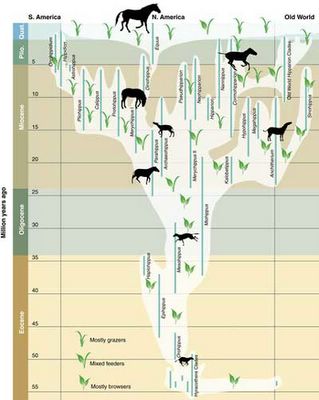



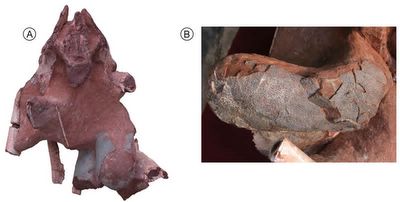
The first dinosaur eggs found complete with shells in the body of the mother has solved the long-standing mystery of how dinosaurs laid their eggs. The evidence shows they laid a clutch in a series of sittings, like birds, rather than all at once like crocodiles and other living reptiles.
Oviraptors are part of the wide-ranging group called theropods, which also includes Tyrannosaurs and the ancestors of birds. Their fossilised nests are well known in China, typically including over a dozen elongated oval eggs in two rings.
Too little is preserved of the new find to identify the particular species, but the newly eggs looked ready to be laid, says Tamaki Sato of the Canadian Museum of Nature in Ottawa.
The best-preserved egg of the find is nearly 20 centimetres long and 6 to 8 cm wide, although somewhat deformed. Sato says the egg's shape and microscopic structures match those of some previously found eggs.
The pair of eggs show the oviraptor developed one egg at a time in each of its two oviducts, most probably laying one pair at a time in the nest, Sato suggests.
That puts it somewhere between the primitive reptilian form of crocodiles and the more advanced form of the birds, consistent with the theory that birds evolved from dinosaurs related to oviraptors.













